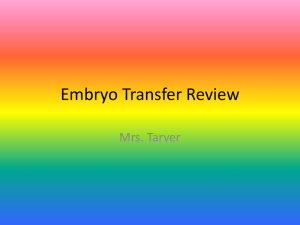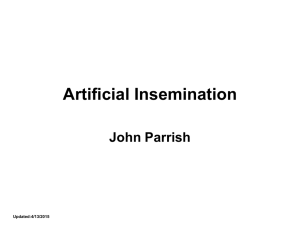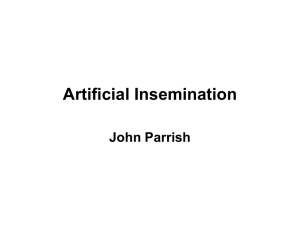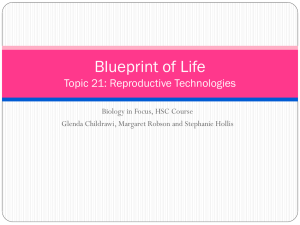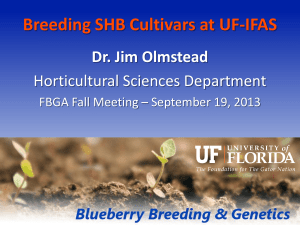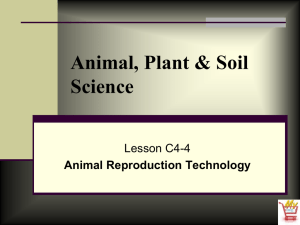Meat Goat Production - Illinois Meat Goat Producers
advertisement
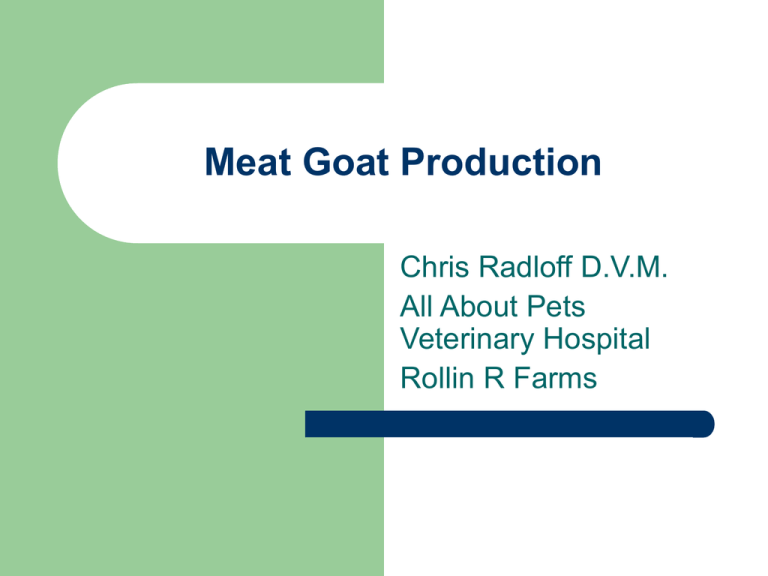
Meat Goat Production Chris Radloff D.V.M. All About Pets Veterinary Hospital Rollin R Farms Factors for Successful Production 1. Nutrition 2. Health 3. Reproduction 4. Marketing 5. Facilities Nutrition Is the highest cost item associated with production Adjust for animal needs (ie. Early pregnancy, Late Pregnancy, Lactation, Kids and Bucks) Feed Costs Different for each farm due to variable facilities, markets, breed variables, and management. – Example 50 doe farm Pre- breeding- Early gestation late summer-fall pasture and grain – Grain expense $9.00 per day Early Gestation to late gestation Winter-early spring hay and grain – Hay expense $15.00 per day – Grain expense $4.50 per day Feed Costs – Late Gestation thru lactation early spring to summer grain and pasture Grain expense $9.00 per day Total- $4510.00 or ~$90 per head per year – – – Pre- breeding- Early gestation $1080.00 Early Gestation to late gestation $2350.00 Late Gestation thru lactation $1080.00 Health Deworming Vaccines Regular hoof care Body Condition Score FAMACHA Score Reproduction Produce kids for market Produce kids for replacements Reproduction Basics Does (females) Bucks (males) Seasonal Polyestrus Puberty between 4-10 months of age Pregnancy lasts approx 150 days Twins and Triplets are common Does Should be 60-70% of adult weight at breeding Can breed to kid as yearlings Accelerated Kidding – Breeding to have 3 kid crops in 2 years Does Seasonal breeders – – – – – Short days signal the breeding season Typically August-February Most meat goats are seasonal breeders Lights and hormones can be used to manipulate breeding season Buck Effect Estrous Cycle 18-22 days long Estrus 12-36 hours Ovulation occurs at end of Estrus Signs of Estrus Tail Wagging Swollen vulva Mounting behavior Clear discharge from vulva Vocalizing Increase in activity Bucks Reach puberty 3-6 months of age Need to separate or castrate by 4 months of age to prevent unwanted pregnancies Can use as herd sires at 8-10 months of agebut limit number of does Breeding Soundness Exam (BSE) performed prior to breeding season Breeding Season You want to have a defined breeding season – – Breeding seasons are typically 60-90 days Breeding season should not be 365 days Your breeding season should be determined by: – – – – – Weather Forage availability Management Time availability When you plan to market or show animals Assisted Reproduction Valuable tools for increasing the impact of outstanding genetics, but also require increased management, cost, and risk. – – Artificial Insemination Embryo Transfer Artificial Insemination Bucks are collected via; •Artificial Vagina and Doe in Estrus or Electro-ejaculator Semen is examined, extended, and frozen. Semen is placed above or just inside the cervix by means of a glass speculum and pipette. Typical conception rates are 30-50% for one insemination or 60-80% with 2 or three inseminations. Laparoscopic AI increases the success rate but also the danger to doe and the cost. Artificial Insemination Plan ahead of time- Months not Weeks – – – – Select does and bucks Vaccinate 2-3 months prior Multimin or BoSe Injection 2-3 months prior Nutritional Flush 4-6 weeks prior Increase feed intake Monitor BCS Can increase ovulation rate 5-10% Artificial Insemination Semen tank Speculum AI Gun Light source Thaw Jar Staw Cutter Restraint Training Artificial Insemination Timing of Insemination – – – Toward end of standing estrus Multiple inseminations 12 hour intervals Pass pipette through cervical rings Laparoscopic Insemination/ Surgical Insemination Increased conception rate over transcervical Can use smaller amounts of semen Increased costs Increased risks for doe Does typically need to be synchronized Laparoscopic Insemination/ Surgical Insemination Synchronizing protocol – – – – – Day 0- Insert CIDR Day 10- Give Prostaglandin Injection (Estrumate or Lutalyse) Day 12- Removed CIDR and Injection of PG600 Day 13- Pull food and Water Day 14- Perform Insemination procedure Laparoscopic Insemination/ Surgical Insemination Synchronizing protocol – – – – Day 0- Lutalyse Injection Day 7- Cystorelin Injection Day 14- Lutalyse Injection Day 17- Cystorelin Injection and perform AI procedure. Embryo Transfer Breeding genetically superior animals to increase chances of more offspring Costly Variable results Increased risks Embryo Transfer Good intense management PLAN AHEAD No shortcuts Embryo Transfer AVOID STRESS Some examples of how stress is induced are: -Mixing groups or individual animals together that have not previously been together. -Altering the goats regular routine. -Handling the goats unnecessarily. -Confining goats in close or unfamiliar surroundings. -Causing goats to become frightened, such as exposure to predators -Weather extremes Embryo Transfer The ease with which your goats can be handled and the avoidance of stress from a period of time before you began an ET period until at least the second month of pregnancy will reflect drastically on your conception rates and ultimately the number of kids born. Embryo Transfer TEASER BUCKS – – – – – Very important to overall success Recipients and Donors must be exposed to teasers Initiate Estrus Minimum of 30 days, and preferably 60 days, prior Vassectomized can still penetrate the females which allows for better stimulation. Embryo Transfer TEASER BUCKS – – – – One teaser buck per small Donor groups (5) One teaser per 25 Recipients Use Teasers both before you begin a program and during heat detection at mating time. Harnesses with different colored chalk can be strapped to teaser bucks and is helpful in heat detection. Planning for Embryo Transfer •Positive weight gains throughout an ET program -Nutritional Flush 4-6 weeks prior Increase feed intake Monitor BCS Vaccinate 2-3 months prior Multimin or BoSe Injection 2-3 months prior Embryo Transfer Protocol Day 0: Insert CIDR in Recipient and Donor does Day 12: Give 1.5ml of Follitropin in P.M. Day 13: Give 1.5ml of Follitropin in A.M. and 1.25ml in P.M. Day 14: Give 1.25ml of Follitropin A.M. and 1.0ml in P.M. Remove recipient CIDR in P.M. Day 15: Give 1.0ml of Follitropin in A.M. and 0.75ml in P.M. Day 16: Remove Donor CIDR in P.M. Day 17: Give 0.5ml Follitropin in A.M. Breed donors when in heat. Perform surgical A.I. 12-18 hours after first sign of heat. Observe recipients for signs of heat. Day 19-20: Insert new CIDR into donor Day before Flush Full food and water from donors and recipients in P.M Day 23-24: Perform Flush Embryo Transfer EXAMPLE OF AN ET PROGRAM SCHEDULE: DAY 0-Put CIDRs In Recipients DAY 1-Put CIDRs In Donors DAY 16-Donor FSH Injections in AM & PM DAY 17-Donor FSH Injections in AM & PM DAY 18-Donor FSH Injections AM & PM and Recipient CIDRs Out in PM DAY 19-FSH Inject. in AM & PM, Donor CIDRs Out in PM & Record Recip Heats DAY 20-Mate Donors in the AM & PM and Record Recipient Heats DAY 21-Mate Donors in the AM And Record Recipient Heats DAY 23 -Put New CIDRs Back In Donors DAY 25-Take Both Donors and Recipients Off Feed & Water DAY 26-ET Day:Flush & Lutalyse Donors, and Transfer Embryos To Recips Embryo Transfer Does are mated at 12 hr. intervals beginning at onset of heat and continuing until she will no longer accept the buck. One ejaculation per breeding is sufficient. Don't overwork your bucks. Do not put a buck with a group of donor does and leave him. He will very likely service only one donor. Embryo Transfer The collection is done by literally washing the inside of the uterus with a fluid media in which the embryos become suspended and then searching this fluid aided with the use of a low powered microscope. After evaluating the superovulatory response of the donor by observing the ovaries, the horns of the uterus are exposed, one at a time, through a small incision just in front of the udder. Each horn is collected separately, using approximately 60 ml of media for each side. Embryo Transfer Results from superovulation are varied. Averages are approximately: – – – – – 8 useable embryos from doe kids 10-12 useable embryos from adults Older does work the best Program 6-8 recipients on kid flushes 8-10 recipients on adult flushes Embryo Transfer Two embryos are routinely transferred to each recipient The recipients undergo the same type of general anesthesia as the donors. The ovaries and uterus are examined After a recipient has been determined acceptable, a small portion of the uterus is exposed through a small incision in the abdominal wall, and two embryos are injected via a needle puncture into the uterine horn on the same side that ovulation occurred. Post transfer recipient care is also critically important. The avoidance of stress during this period can influence conception and kidding rates positively Reproduction Pregnancy Diagnosis – Ultrasound – Can be detected 30-35 days after breeding BioPRYN Testing Blood sample to determine pregnancy Can collect samples 30 days post breeding Cost $6.50 per test Marketing Identify your market – – – – – – – Local Auctions Traders Breeding Stock Individual consumers Processors Producer Cooperative Grazing for hire Marketing Covering costs – – Market 50-70# Prices variable throughout the year Example 50 doe farm (~$90.00 per doe for feed cost) – – – – 85 kids Market at 60lbs $1.75/lb Total Sales of $8925.00 or ~$178.00 per doe Facilities Fencing Sheds – – – Kidding area – 5 sq. ft. per adult animal Sturdy and durable Protection from rain, cold wind, and snow Jugs or hutches Catch pen The End


